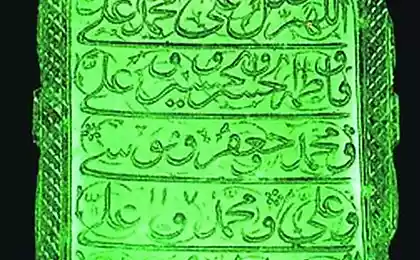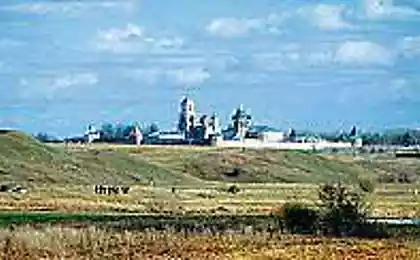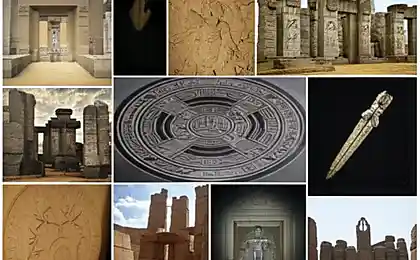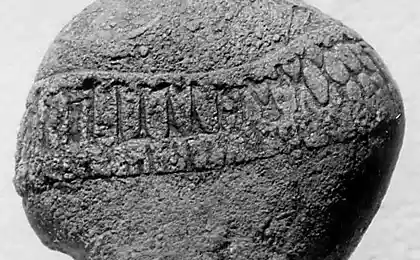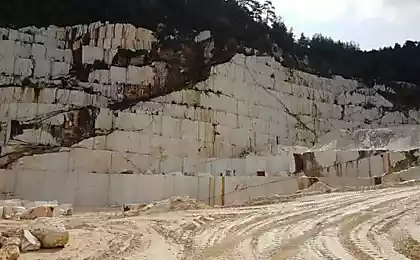455
The blue stone: questions without answers?
Near the town of Pereslavl-Zalessky on lake Pleshcheyevo began to emerge from the ground and move a huge 12 ton boulder, is the best place of worship of the Gentiles, the legendary Blue — stone, a cursed Church in the middle ages.
In Russia there are two of the most famous stone. First — Thunder-stone on which the sculptor Falconet set a monument to Peter I in St. Petersburg — the famous officially became part of Imperial Russian history. Second, the Blue stone, surrounded by so many incredible myths, legends and stories that most modern scientists just don't know which end to unravel his mysteries.
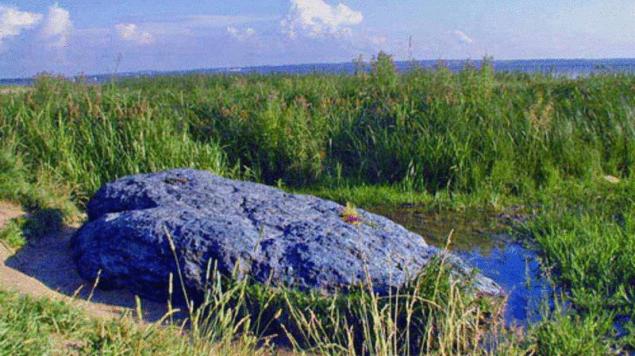
Agree on one thing. The boulder served as a temple of the Finnish tribes that lived in this area until the ninth century. He was sacrificed, worshipped, honored. Believed that the stone lives the spirit of a powerful God. Then came the Slavs, too, the Gentiles, and the worship continued. Here is what Valery Chudinov, RANS academician, Chairman of RAS: "Not long ago, a Blue-stone had traces of Slavic runes (they were used before the Cyrillic alphabet came into use). We managed to decipher the inscriptions. One of them: Perunov stone. No doubt that he was dedicated to one of the most important of the pagan gods in the Pantheon of ancient Russian religion."
After the baptism of Rus as the artifact of an ancient pre-Christian culture could not remain indifferent to the Church. And as is often the case, the official ideology has done everything to stop the pilgrimage to the stone. How? Bishops cursed him and tried to destroy it. Here's what reliably describe the documents. In 1152 the Christians went up on the mountain where lay the Blue stone, and threw it down. But people continued to walk to the defeated pagan idol. In the XVII century in a duel with him came the deacon Pereslavl semenovskoy Church Onufri. He dug a pit, dumped it with the rest of the parish “stone the devil” and covered with earth. But after a few years boulder for the first time demonstrated the craving for self-movement and the “peeking out” from under the ground.
And then again it reached the people. In the winter of 1788, the stone drowned in the lake Pleshcheyevo at a depth of about 5 meters. Soon the fishermen began to report that the boulder is slowly but steadily crawling along the bottom in the direction of “his” mountain. The movement was barely noticeable, but in the spring of 1850 he came to the foot of the hill which was cast out. And still didn't stop. Photos of the 50-ies of the last century saw the lump on the shore of the lake, and decades later the boulder was already at a distance of one hundred meters from this place. And still the people come. Someone asks to rid of disease, while others make a wish and believe that the Blue stone will do it.
Ten years ago there worked a group of researchers. "A fine-grained quartz biotite schist" — gave Blue stone the assessment geologists. Your color it gets only morning sun, when, wet from the dew, reflects the sky. On moonlit nights a shade more purple. Another paradox: "On one edge — perfectly normal radiation situation around 0.14 micro-roentgen per hour, and on the other a few times higher." The conclusion of the expedition a few ambiguous: "Chunk is located at the intersection of some "energy" lines — because and move." The very movement, alas, were not recorded. As well as it does not explain why he never covered with snow and sometimes glows at night.
And now for the first time received credible evidence of the "walk" of stone. But not researchers and filmmakers. Producer of “Hypothesis” Alexander Volkov says:
-We are in autumn and early winter made a film about the unusual natural phenomena that occur around lake pleshcheeva. In one of the first days I tried to record the ancient inscriptions on stone. Failed. They are only visible from a certain point, only in the morning and only in bright sunlight. Not to lose perspective, marked by pegs of the place in which rested the tripod of the camera. When after two weeks they returned, they found that the stone “crawled” inches to eight! It was interesting. Continued measurements. For three and a half month of our Boulder moved more than 40 cm, and raised 4-5 inches!
-What the locals say?
They just do not notice. Every day I walk past, an inch there, two back (laughs). You will notice, when a lamp post outside your house gradually shifted over half inches at fifty?..
Too many esoteric puzzles for our technogenic century enlightened...
-I'm not a mystic. But... When we put together all the anomalies that occur in the area (ball lightning, glow, unusual wildlife, which met in the district), it became clear that they, most likely — a common reason. Perhaps the Blue stone — a piece of a global ecosystem, of which we know nothing. And the fact that he is not in his place, leads to the appearance of "miracles" in the area. Therefore, the Blue stone and moves to occupy the allotted nature of the place.
In such cases it is customary to ask: "So what do you expect from "signs"? Disasters, floods, revolution?
-I don't think. I think his movement is the path to harmony.
"The stone is a piece of plate with a thickness of about 0.6 meters, oval, somewhat elongated. Its long axis is 2.9—3.1 meters and is oriented almost exactly along the line West—East; the width of the stone is about 2.6 meters. Stone well okatan, no sharp edges, but the surface is not smooth, and flecked with small tubercles and cells 3-4 cm in diameter.
The color of the stone is heterogeneous: grey, dark grey and grey-blue tones. Wetting the surface of the matte glitters and becomes dark blue. Mostly dark monolith visible whitish veins, and in the lateral parts it is easy to trace the tracks of layers, characteristic of the original breed. Is fine-grained quartz biotite schist. It is possible that the inner core of the stone are more robust quartz rocks, cementing the whole monolith.
Similar species are the so-called green- (blue-) stone arrays, with the outcrops on the territory of Karelia, Scandinavia and in the southern part of the Onega-Ladoga belt. Most likely, from the Onega-Ladoga area the stone was moved when the movement of the glacier. The age of similar rocks is very solid, more than 2.5—2.6 billion years. The blue color is formed due to the refraction and reflection of light by the surface of the flakes and grains of quartz-biotite (which are black).
The form of the stone suggests that it has undergone considerable processing by the glacier. This is understandable, because the stone moved 600 kilometers from the place of its indigenous occurrence.
Blue stone, of course, refers to glacial boulders, although different from the classical examples is relatively flat and the top and base.
Conducted measurements allowed us to calculate the volume and weight of the stone. A volume of about 4 cubic meters. The average density of similar rocks, equal to 2.9 to 3.0 grams per centimeter cubed, the mass of the stone is approximately 12 tons." published
P. S. And remember, just changing your mind — together we change the world! ©
Source: /users/1077
In Russia there are two of the most famous stone. First — Thunder-stone on which the sculptor Falconet set a monument to Peter I in St. Petersburg — the famous officially became part of Imperial Russian history. Second, the Blue stone, surrounded by so many incredible myths, legends and stories that most modern scientists just don't know which end to unravel his mysteries.

Agree on one thing. The boulder served as a temple of the Finnish tribes that lived in this area until the ninth century. He was sacrificed, worshipped, honored. Believed that the stone lives the spirit of a powerful God. Then came the Slavs, too, the Gentiles, and the worship continued. Here is what Valery Chudinov, RANS academician, Chairman of RAS: "Not long ago, a Blue-stone had traces of Slavic runes (they were used before the Cyrillic alphabet came into use). We managed to decipher the inscriptions. One of them: Perunov stone. No doubt that he was dedicated to one of the most important of the pagan gods in the Pantheon of ancient Russian religion."
After the baptism of Rus as the artifact of an ancient pre-Christian culture could not remain indifferent to the Church. And as is often the case, the official ideology has done everything to stop the pilgrimage to the stone. How? Bishops cursed him and tried to destroy it. Here's what reliably describe the documents. In 1152 the Christians went up on the mountain where lay the Blue stone, and threw it down. But people continued to walk to the defeated pagan idol. In the XVII century in a duel with him came the deacon Pereslavl semenovskoy Church Onufri. He dug a pit, dumped it with the rest of the parish “stone the devil” and covered with earth. But after a few years boulder for the first time demonstrated the craving for self-movement and the “peeking out” from under the ground.
And then again it reached the people. In the winter of 1788, the stone drowned in the lake Pleshcheyevo at a depth of about 5 meters. Soon the fishermen began to report that the boulder is slowly but steadily crawling along the bottom in the direction of “his” mountain. The movement was barely noticeable, but in the spring of 1850 he came to the foot of the hill which was cast out. And still didn't stop. Photos of the 50-ies of the last century saw the lump on the shore of the lake, and decades later the boulder was already at a distance of one hundred meters from this place. And still the people come. Someone asks to rid of disease, while others make a wish and believe that the Blue stone will do it.
Ten years ago there worked a group of researchers. "A fine-grained quartz biotite schist" — gave Blue stone the assessment geologists. Your color it gets only morning sun, when, wet from the dew, reflects the sky. On moonlit nights a shade more purple. Another paradox: "On one edge — perfectly normal radiation situation around 0.14 micro-roentgen per hour, and on the other a few times higher." The conclusion of the expedition a few ambiguous: "Chunk is located at the intersection of some "energy" lines — because and move." The very movement, alas, were not recorded. As well as it does not explain why he never covered with snow and sometimes glows at night.
And now for the first time received credible evidence of the "walk" of stone. But not researchers and filmmakers. Producer of “Hypothesis” Alexander Volkov says:
-We are in autumn and early winter made a film about the unusual natural phenomena that occur around lake pleshcheeva. In one of the first days I tried to record the ancient inscriptions on stone. Failed. They are only visible from a certain point, only in the morning and only in bright sunlight. Not to lose perspective, marked by pegs of the place in which rested the tripod of the camera. When after two weeks they returned, they found that the stone “crawled” inches to eight! It was interesting. Continued measurements. For three and a half month of our Boulder moved more than 40 cm, and raised 4-5 inches!
-What the locals say?
They just do not notice. Every day I walk past, an inch there, two back (laughs). You will notice, when a lamp post outside your house gradually shifted over half inches at fifty?..
Too many esoteric puzzles for our technogenic century enlightened...
-I'm not a mystic. But... When we put together all the anomalies that occur in the area (ball lightning, glow, unusual wildlife, which met in the district), it became clear that they, most likely — a common reason. Perhaps the Blue stone — a piece of a global ecosystem, of which we know nothing. And the fact that he is not in his place, leads to the appearance of "miracles" in the area. Therefore, the Blue stone and moves to occupy the allotted nature of the place.
In such cases it is customary to ask: "So what do you expect from "signs"? Disasters, floods, revolution?
-I don't think. I think his movement is the path to harmony.
"The stone is a piece of plate with a thickness of about 0.6 meters, oval, somewhat elongated. Its long axis is 2.9—3.1 meters and is oriented almost exactly along the line West—East; the width of the stone is about 2.6 meters. Stone well okatan, no sharp edges, but the surface is not smooth, and flecked with small tubercles and cells 3-4 cm in diameter.
The color of the stone is heterogeneous: grey, dark grey and grey-blue tones. Wetting the surface of the matte glitters and becomes dark blue. Mostly dark monolith visible whitish veins, and in the lateral parts it is easy to trace the tracks of layers, characteristic of the original breed. Is fine-grained quartz biotite schist. It is possible that the inner core of the stone are more robust quartz rocks, cementing the whole monolith.
Similar species are the so-called green- (blue-) stone arrays, with the outcrops on the territory of Karelia, Scandinavia and in the southern part of the Onega-Ladoga belt. Most likely, from the Onega-Ladoga area the stone was moved when the movement of the glacier. The age of similar rocks is very solid, more than 2.5—2.6 billion years. The blue color is formed due to the refraction and reflection of light by the surface of the flakes and grains of quartz-biotite (which are black).
The form of the stone suggests that it has undergone considerable processing by the glacier. This is understandable, because the stone moved 600 kilometers from the place of its indigenous occurrence.
Blue stone, of course, refers to glacial boulders, although different from the classical examples is relatively flat and the top and base.
Conducted measurements allowed us to calculate the volume and weight of the stone. A volume of about 4 cubic meters. The average density of similar rocks, equal to 2.9 to 3.0 grams per centimeter cubed, the mass of the stone is approximately 12 tons." published
P. S. And remember, just changing your mind — together we change the world! ©
Source: /users/1077
The iceberg of the brain: our subconscious mind is smarter than we thought
50 quotes to help you let go and move on


